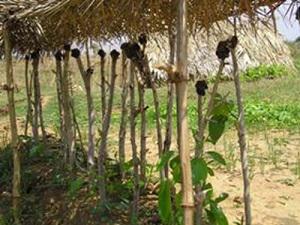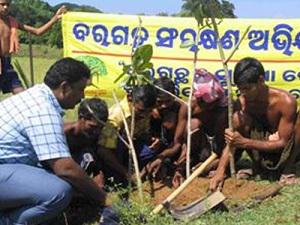Biswajit Mohanty
Other projects
The project seeks to spread awareness and education among the local community of the tremendous importance of the banyan tree and mobilize them into protecting the trees in their own villages and nearby areas.

Banyan saplings being raised for planting at a nursery at Dandiri.
This project is a second year continuation project for the work already executed during the first year when 50 banyan trees were identified for protection by fencing of the hanging roots. During the current year, an additional 30 trees shall be taken up for such protection .

Planting a new banyan sapling at Thokar village.
Only those trees which had developed hanging roots that are suspended a few feet from the ground shall be suitable. The banyan tree (Ficus Benghalensis ) is a common tree of India which is also highly useful for the local ecology since it is a nesting place for avifauna as well as a refuge for squirrels and bats. The red fruits of the tree are useful for birds, squirrels and bats and leaves are plucked for use as cattle fodder. The banyan tree is also worshipped in many villages since it considered as a holy tree by Hindus.
Banyan trees depend upon their hanging roots to get support for the extended branch network . The project seeks to protect the hanging roots from destruction due to cutting by humans and nibbling by goats. Protection of these roots for at least two years during the growth phase would enable them to strike the ground.
The project seeks to spread awareness and education among the local community of the tremendous importance of the banyan tree and mobilize them into protecting the trees in their own villages and nearby areas. Animators would be moving among the villagers and educating them . Audio visual methods like posters, wall paintings, stickers and illustrated brochures explaining the idea behind the project would also be used in a big way to achieve the objectives. Signboards in the local language which would have messages would be put up on the trees. School children shall also be motivated through school meets and rallies for banyan tree protection. Planting of new saplings by the villagers in village commons and roadside would also be encouraged.